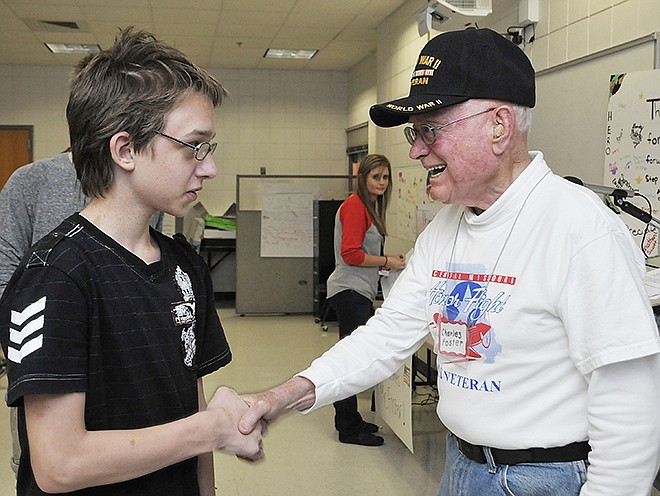History leaped to life on Thursday when Charles Foster, a soldier in World War II, shared his Honor Flight experiences - and his war-time memories - with a group of Lewis and Clark Middle School students in Jefferson City.
Galvanized by the death of a close buddy at Pearl Harbor, Foster was barely 21 years old when he enlisted in the U.S. Army in 1942.
Over the course of the next three years, he fought in both the North African and Italian campaigns and was headed toward Germany when enemy forces surrendered in May 1945.
During the course of his service, Foster was awarded three Bronze Star Medals.
His remarks focused on his experience as a Honor Flight participant in 2009. Seventy-five men - more than half confined to wheelchairs - traveled with him on the trip.
"The treatment we received was first-rate," he said.
The first Honor Flights were organized in 2005, shortly after the new National World War II Memorial was dedicated in 2004. Since then, Missouri supporters have sent almost 2,000 veterans to see it, he said.
Although Foster, at age 93, is still in fit physical condition - he walks three miles daily - many of his fellow veterans did not survive long enough to experience the memorial, he said.
Foster's family helped him make the arrangements, he said.
"It was the best Father's Day gift I could receive," he said. "When we got on the bus, the Missouri Highway Patrol escorted us with motorcycles all the way to St. Louis."
Logistically, the trip wasn't easy, although organizers made it as streamlined for the elderly veterans as possible. Many of the men had not flown since 9/11, and were surprised by the TSA's mandatory security checks.
"It was strange all these veterans - many have shrapnel in the them, and knee replacements - having to be screened," he said. "Finally we all got on the flight to Baltimore."
With more than 40 men in wheelchairs, getting off the plane took time, too, he said.
But when the group walked through the airport, people greeted the group with cheers and whistles.
"It was emotional to experience that appreciation for military service so long ago," he said.
Although the trip's highlight was visiting the World War II memorial, the group also fit in side trips to Arlington National Cemetery and the Korean and Vietnam War memorials. Foster told the students he was particularly struck by the realism of the Korean monument.
"See how the men are all looking in different directions? They are on scout duty. ... they are alert for danger from every direction," he said. "That really brought the war back so clearly to me."
Foster also described the World War II memorial for students, sharing with them a few dozen pictures of the monument.
He said, for many of the men, the Freedom Wall - which has 4,048 gold stars, one for every 100 Americans killed - was the most emotionally potent symbol.
"It really affected all of us men as we stood before the wall," he said.
He said one of the main differences between the war fought in the 1940s and the conflicts today were the extent people on the home front were expected to sacrifice. Seventy years ago, all kinds of commodities - sugar, rubber, steel - were rationed so factories could keep the front lines continuously supplied.
"Today, with Iraq and Afghanistan, we're not immersed in this. There's no sacrifices we're making," he said. "Everyone felt World War II."
After he concluded his presentation, curious students peppered him with more than a dozen questions, asking: What kind of training did he need? Did he graduate from college? Why did he go to war? Did he get to meet people from other countries? What kind of guns did he use? How long did he have to survive without eating and sleeping? Was it scary? Did he have to learn to move silently? What did it feel like the day the war ended? What made him keep going?
Foster answered all their questions patiently.
"I kept going because I knew if I stopped, I'd be killed," he said.
As the visit concluded, each student in the room shook his hand.
Alyson Fontaine, 12, said Foster reminded her of the enormity of the sacrifices made more than 70 years ago.
"You don't really realize how big it is, until you hear it from him. It makes you tear up," she said.

